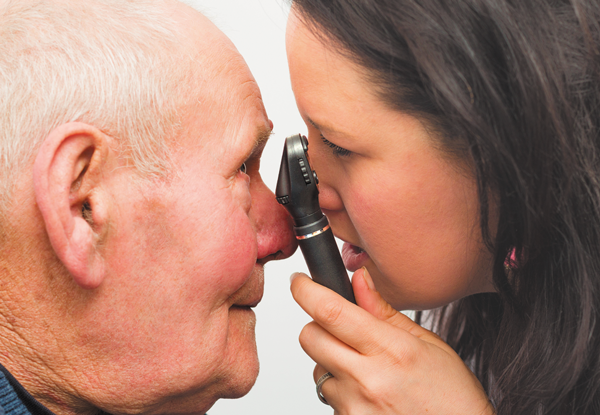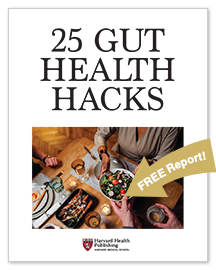
5 timeless habits for better health

What are the symptoms of prostate cancer?

Is your breakfast cereal healthy?

When pain signals an emergency: Symptoms you should never ignore

Does exercise give you energy?

Acupuncture for pain relief: How it works and what to expect

How to avoid jet lag: Tips for staying alert when you travel

Biofeedback therapy: How it works and how it can help relieve pain

Best vitamins and minerals for energy

Should you take probiotics with antibiotics?
Medical Tests & Procedures Archive
Articles
Radiation: Another treatment choice for prostate cancer
Used alone or with hormone therapy, radiation can be a viable option for men at any stage of prostate cancer.
Image: BigStock
Nowadays, men diagnosed with prostate cancer are often given two treatment choices, on opposite ends of the spectrum. First is active surveillance, where you forgo immediate treatment and monitor the cancer's growth. The other is surgery to remove the cancerous prostate.
But an in-between option might be a better choice for men who do not want the anxiety of wait-and-see or the physical hardship of surgery: radiation therapy.
Recovering from bypass surgery
Recovering from heart bypass surgery usually takes at least six weeks. Common challenges include feeling weak and tired, a loss of appetite, constipation, and depression. Also, heavy lifting and driving should be avoided.
Is your heart healthy enough for surgery?
If you're at risk for heart disease, you may need additional testing before a hip replacement or other major surgery.
Image: photodisc/Thinkstock
All surgery, even minor procedures like cataract removal, involves a certain amount of stress. People facing surgery might experience emotional stress related to their illness or condition, often coupled with concerns about their recovery.
Some of the most common noncardiac surgeries done in older people, such as a hip replacement or gallbladder removal, can also put physical stress on the heart. Anesthesia and the operation itself can causes changes in heart rate and blood pressure as well as unmask previously undiagnosed heart disease.
Your blood work, on the edge of normal
What to do when routine test results are at the high or low end of the acceptable range.
Catching early changes in blood work may help prevent chronic disease, such as diabetes.
Image: Ca-ssis/Thinkstock
As a smart medical consumer, you know it's important to look over the results of your routine blood work, even when the numbers are all within the normal range. But what if you notice that some results are at the high or low end of that range? Should you be concerned about this?
A look at corrective eye surgery
Some procedures may help you escape the need for glasses.
Monovision LASIK and lens replacement surgery may help you see more clearly.
Image: a.collectionRF/Thinkstock
You cannot avoid declining vision. After age 40, everyone begins to experience some form of presbyopia, a condition coined from the Greek words for "old sight."
Does double knee surgery make sense for you?
The idea of having a knee replaced is daunting. But what if both of your knees need repairing? Is one visit to the operating room better than two?
If you are otherwise in good health, it's a conversation worth having with your doctor and rehabilitation team. There are some benefits to replacing both joints during a single surgery (called simultaneous replacement). These include undergoing anesthesia only once, fewer days in the hospital, and only one (albeit prolonged) rehabilitation that lets you resume normal activities sooner than two separate ones.
What's the latest in cataract surgery?
Advances in imaging, measuring, and lenses are making the procedure even better.
Image: Thinkstock
A cataract—clouding of the lens inside the eye—is a common cause of poor vision and blindness among older adults. But cataracts can be removed and replaced with artificial lenses. Sound scary? It's not. "Cataract surgery is something that just about everyone will need if you live long enough. Thankfully, with all of the tools and technologies at our disposal, much of it has become fairly routine. The vast majority of people have excellent outcomes with improvement in their quality of vision," says Dr. Christian Song, a cataract and refractive surgeon at Harvard-affiliated Massachusetts Eye and Ear Infirmary.
Typical surgery
Cataract surgery is an outpatient procedure. To remove the cataract, the surgeon makes a circular incision around the eye's lens, and then uses ultrasound technology to break up and remove the cloudy lens. After that, a new lens is slipped into the eye.
Muscle problems caused by statins: Can a genetic test reveal your risk?
A mail-order saliva test marketed to consumers may make some promises it can't deliver.
A new mail-order genetic test called StatinSmart bills itself as the first test to identify a person's risk of experiencing muscle pain from a statin. That sounds like potentially helpful information, given that up to half of people who are prescribed statins quit taking them because of perceived side effects—most often muscle pain. Others avoid statins altogether because of that worry.
But here's the rub: muscle problems can range from mild to serious, and the terms experts use to describe them can be confusing. The StatinSmart website says 29% of people who take a statin develop "statin-induced myopathy," which they define as muscle aches, pains, weakness, or cramps.
Test may diagnose prostate cancer more accurately
A study in the December 2015 issue of The Lancet Oncology found that a new test, called STHLM3, is more helpful at detecting aggressive cancer than traditional tests for prostate-specific antigen (PSA).
The STHLM3 test is a blood test that analyzes a combination of six protein markers, more than 200 genetic markers, and various clinical data, such as age, family history, and previous prostate biopsies.
Ask the doctors: What determines whether a woman needs a cesarean section?
Ask the doctors
Q: I'm expecting and want to have a vaginal delivery, but many of my friends have had cesarean sections lately. Is this a preference, or are there medical reasons to have a cesarean?
A: The health of the mother and baby, the family's personal preferences, and the hospital in which a woman delivers her baby play a role in determining whether she has a cesarean. Common medical reasons for cesareans include fetal malpresentation (when the baby is turned so that its feet or buttocks will come out first), pelvic disproportion (a birth canal that is unusually shaped or too small in relation to the size of the baby), and a past cesarean. A study published in the Journal of the American Medical Association in December 2015 suggests that such commonly cited medical issues may account only partly for high cesarean rates.

5 timeless habits for better health

What are the symptoms of prostate cancer?

Is your breakfast cereal healthy?

When pain signals an emergency: Symptoms you should never ignore

Does exercise give you energy?

Acupuncture for pain relief: How it works and what to expect

How to avoid jet lag: Tips for staying alert when you travel

Biofeedback therapy: How it works and how it can help relieve pain

Best vitamins and minerals for energy

Should you take probiotics with antibiotics?
Free Healthbeat Signup
Get the latest in health news delivered to your inbox!
Sign Up











